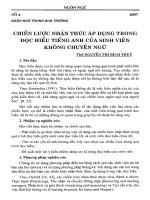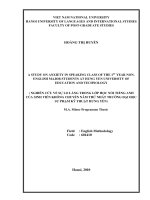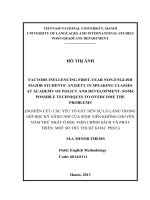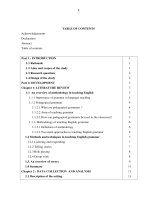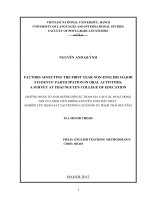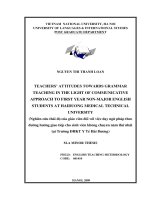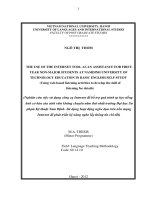Nghiên cứu về sự lo lắng trong lớp học nói tiếng Anh của sinh viên không chuyên năm thứ nhất trường Đại học Sư phạm Kỹ thuật Hưng Yên
Bạn đang xem bản rút gọn của tài liệu. Xem và tải ngay bản đầy đủ của tài liệu tại đây (1.56 MB, 52 trang )
VIET NAM NATIONAL UNIVERSITY
HANOI UNIVERSITY OF LANGUAGES AND INTERNATIONAL STUDIES
FACULTY OF POST-GRADUATE STUDIES
HOÀNG THỊ HUYỀN
A STUDY ON ANXIETY IN SPEAKING CLASS OF THE 1
ST
YEAR NON-
ENGLISH MAJOR STUDENTS AT HUNG YEN UNIVERSITY OF
EDUCATION AND TECHNOLOGY
( NGHIªN CỨU VỀ SỰ LO LẮNG TRONG LỚP HỌC NãI TIẾNG ANH
CỦA SINH VIªN KH«NG CHUYªN NĂM THỨ NHẤT TRƯỜNG ĐẠI HỌC
SƯ PHẠM KỸ THUẬT HƯNG YªN)
M.A. Minor Programme Thesis
Field
: English Methodology
Code
: 601410
Hanoi, 2010
VIET NAM NATIONAL UNIVERSITY
HANOI UNIVERSITY OF LANGUAGES AND INTERNATIONAL STUDIES
FACULTY OF POST-GRADUATE STUDIES
HOÀNG THỊ HUYỀN
A STUDY ON ANXIETY IN SPEAKING CLASS OF THE 1
ST
YEAR NON-
ENGLISH MAJOR STUDENTS AT HUNG YEN UNIVERSITY OF
EDUCATION AND TECHNOLOGY
( NGHIªN CỨU VỀ SỰ LO LẮNG TRONG LỚP HỌC NãI TIẾNG ANH
CỦA SINH VIªN KH«NG CHUYªN NĂM THỨ NHẤT TRƯỜNG ĐẠI HỌC
SƯ PHẠM KỸ THUẬT HƯNG YªN)
M.A. Minor Programme Thesis
Field
: English Methodology
Code
: 601410
Supervisor
: PH¹M THÞ H¹NH, M.A
Hanoi, 2010
iv
Table of content
PART ONE: INTRODUCTION……………………………………………………………… 1
1. Rationale………………………………………………………………………………… 1
2. Aims of the study………………………………………………………………………….1
3. Scope of the study…………………………………………………………………………2
4. Methods of the study………………………………………………………………………2
5. Design of the study………………………………………………………………………. 2
PART TWO: THE STUDY…………………………………………………………………… 4
CHAPTER I: LITERATURE REVIEW……………………………………………………….4
1. Theoretical background of anxiety……………………………………………………… 4
Definition of anxiety…………………………………………………………………… 4
Types of anxiety………………………………………………………………………… 5
Foreign language anxiety…………………………………………………………………5
Sources of foreign language anxiety…………………………………………………… 6
1.4.1. Subjective factors………………………………………………………………… 7
1.4.2. Objective factors………………………………………………………………… 8
Effect of anxiety on learning…………………………………………………………… 9
Components of foreign language anxiety……………………………………………….10
1.6.1. Communication apprehension ………………………………………………… 10
1.6.2. Fear of negative evaluation………………………………………………………11
1.6.3. Test anxiety………………………………………………………………………11
2. Theoretical background of speaking activities ………………………………………… 12
Concepts of speaking activities…………………………………………………………12
Roles of speaking activities…………………………………………………………… .12
CHAPTER II: METHODOLOGY………………………………………………………… 14
1. The context…… ……………………………………………………………………… 14
2. The informants………………………………………………………………………… 14
3. The instruments………………………………………………………………………… 15
Survey questionnaire……………………………………………………………………. 16
Semi-structured interview……………………………………………………………… .17
CHAPTER III: DATA ANALYSIS AND FINDINGS……………………………………… 19
1. Level of speaking anxiety experinced by UTEHY non- English major freshmen …… 19
Communication anxiety……………………………………………………………… 19
Fear of negative evaluation…………………………………………………………… . 21
v
Test anxiety………………………………………………………………………… 23
2. Sources of students’ speaking anxiety………………………………………………… . 23
Subjective factors……………………………………………………………………… .24
Objective factors……………………………………………………………………… . 27
CHAPTER IV: SUGGESTED IMPROVEMENTS………………………………………… 30
1. Recommendations for the teachers……………………………………………………… 30
2. Recommendations for the students……………………………………………………… 32
PART THREE: CONCLUSION………………………………………………………………35
1. Summary of the study……………………………………………………………………35
2. Limitations of the study………………………………………………………………… 35
3. Recommendations for further research………………………………………………… 36
REFERENCES I
APPENDIXES………………………………………………………………………………… III
vi
LIST OF ABBREVEATIONS
FLA: Foreign Language Acquisition
FLCAS: Foreign Language Classroom Anxiety Scale
FL: Foreign Language
UTEHY: Hung Yen University of Education and Technology
vii
LIST OF TABLES
Table 1: Criteria to identify groups of FLA levels
Table 2: Level of speaking anxiety experinced by UTEHY non- English major freshmen
Table 3:Level of communication anxiety experinced by UTEHY non- English major
freshmen
Table 4: : Level of fear of negative evaluation experinced by UTEHY non- English major
freshmen
Table 5: Level of test anxiety experinced by UTEHY non- English major freshmen
1
PART ONE- INTRODUCTION
1. Rationale:
Since the open policy was carried out in Vietnam, English has become a useful and
indispensable means for the integration of our country into the world community. Learning
English becomes a great necessity for Vietnamese people. Especially, learning speaking gains
a great stature as the need of communication is paid much more attention.
The result of learning a language, though, is determined and affected by a number of factors. It
is believed that there are some emotional factors in foreign language learning which affect our
learning abilities. These are mainly thought to be intelligence, motivation, attitudes and
anxiety. Among these, anxiety stands out as one of the major influential factors for effective
language learning. This foreign language anxiety is defined by some authors as “a feeling of
tension, apprehension and nervousness associated with the situation of learning a foreign
language.”(Horwitz, Horwitz & Cope, 1986, p.125)
In fact, in speaking lesson in Hung Yen University of Technology and Education, students are
usually reluctant to take part in class activities. Speaking tasks often take place in silence.
Some students may be very good at writing or reading English but they fail to speak English
fluently and naturally. Some students state that they cannot find words to say. And some say
that they do not like speaking in class. Some frankly admit that they feel nervous and anxious
when speaking.
Learning English in Vietnam has gained a considerable achievement. However, learning
speaking skill in Vietnam is not really efficient in comparison with other developed contries.
While a certain amount of research has been conducted to investigate the nature of anxiety in
second and foreign language learning, little has been done on anxiety in learning speaking
skill alone in Vietnam. As a teacher of English, therefore, I decided to conduct research on the
topic: “ A study on anxiety in Speaking class of the 1st year non-English major students
at Hung Yen University of Education and Technology”.
2. Aims and objectives of the study:
2
The study is aimed at anxieties encountered by the first year non English major students in
Economic Department, Hung Yen University of Technology and Education, and then finding
some possible techniques for dealing with students’ anxiety in speaking class. To help the
students overcome such difficulties, the specific objectives of the study are:
- to identify the anxiety and point out factors affecting students’ anxiety in learning
speaking skill
- to suggest some realistic and appropriate pedagogical implications to improve students’
ability to cope with anxiety in learning speaking skill.
3. Scope of the study:
There are many types of anxiety. However, this study only focuses on anxiety of speaking
skill for the First Year Non English majors at Hung Yen University of Technology and
Education. This study is claimed to be an overview of current situations of the first year non
English majors when learning speaking skill and some suggestions for students to cope with
anxiety in speaking class as well as techniques for the teachers to improve their teaching
methods of speaking skills.
4. Methods of the study:
The study will be conducted using quantitative and qualitative methods with questionnaires
for informants of one class of about 30 first- year non majors of English and 15 teachers at the
University of Technology and Education in Hung Yen- Department of foreign languages. In
addition to the questionnaire, informal interviews with the informants and their teachers and
personal observation will also be employed.
5. Design of the study:
3
The study consists of three parts:
Part A, introduction, presents the rationale, the aims, the scope, the methods and the design
of the study.
Part B, development, consists of 3 chapters.
+ Chapter I - Literature Review – provides the basic theoretical background from literature
on anxiety such as definition, types of anxiety; and speaking activities. Especially, the effect
and possible causes of anxiety, which are the main issues of the study, are discussed
thoroughly in this chapter.
+ Chapter II - Practical Research – provides an analysis on the current situation of teaching
and learning speaking skill and reports the results of the survey research which are carried out
at the beginning of the third term of the 2009- 2010 academic year at the foreign language
department, UTEHY. The report includes the following information.
research questions
context
informants
questionnaires and procedures
data analysis and findings
suggested solutions
+ Chapter III – Implications for teaching and learning speaking skill– focuses on anxieties
facing students in learning speaking skill and suggested techniques and activities for the
teachers to improve their teaching, suggested solutions for students to reduce and cope with
anxieties facing them in speaking classes.
Part C, conclusion, summarizes all the key issues as well as the limitations of the study and
suggestions for further study.
4
PART TWO- THE STUDY
CHAPTER I- LITERATURE REVIEW
1. Theoretical background of anxiety:
1.1. Definition of anxiety:
There has been a variety of studies carried out on anxiety. Anxiety is “the subjective feeling of
tension, comprehension, nervousness, and worry associated with an arousal of autonomic
nervous system” (Horwitz, Horwitz & Cope, 1986, p.125). Or “the worry and negative
emotional reaction aroused when learning a second language” (MacIntyre, 1999, p.27).
Second language anxiety is defined here a distinct complex of self- perception, beliefs,
feelings, and behaviors related to using a foreign/ second language for communication beyond
class language.
They identified three related anxieties as components of foreign language anxiety:
communication apprehension, test anxiety and fear of negative evaluation.
In addition “Anxiety is a psychological construct, commonly described by psychologists as a
state of apprehension, a vague fear that is only indirectly associated with an object” (Hilgard,
Atkinson, & Atkinson, 1971 cited in Scovel, 1991:18).
Anxiety, as perceived intuitively by many language learners, negatively influences language
learning and has been found to be one of the most highly examined variables in all of
psychology and education ( adapted from Horwitz, 2001:113).
To sum up, anxiety is a feeling of tension, apprehension and nervousness associated with the
situation of learning a foreign language. In general, it can have physical, emotional, and
behavioral manifestations and these manifestations can differ with each individual.
5
1.2. Types of anxiety:
Usually anxiety is classified into trait anxiety, state anxiety and situation-specific anxiety.
Trait anxiety, as Scovel (1978) noted, refers to “a more permanent predisposition to be
anxious” while state and situation-specific anxiety are usually experienced in relation to some
particular event or situation (Brown, 2001). Language anxiety, the research target of this
paper, belongs to the latter category, which refers to the apprehension experienced when a
situation requires the use of a second language with which the individual is not fully proficient
(Gardner & MacIntyre, 1993).
1.3. Foreign language anxiety: (quoted by Dr. Anna Krinis ( 2007))
1. Language anxiety has been defined as a specific-situation anxiety experience by students
in the process of learning and / or using a foreign or second language.
2. A specific-situation anxiety is an anxiety that arises from a specific-situation such as
flying in an airplane, giving a speech, dealings with math, taking tests, as opposed to a
trait anxiety which is a permanent part of a person’s personality.
3. Horwitz et. al. (1986) say that, “We conceive foreign language anxiety as a distinct
complex of self-perceptions, beliefs, feelings, and behaviors related to classroom
language learning arising from the uniqueness of the language learning process”.
4. In addition to the definition, it is important to point out that anxiety can be both
facilitating – a positive factor assisting people towards success – and debilitating – a
negative factor, blocking or preventing people from success.
5. Speaking in the foreign / second language has been cited in the literature as the greatest
source of anxiety, followed by listening, as opposed to reading and writing.
6. Anxiety, in general, can have physical, emotional, and behavioral
manifestations and these manifestations can differ with each individual.
6
In addition to these types of foreign language anxiety above, there is a version of Foreign
Language Classroom Anxiety Scale (FLCAS) that was designed by Horwitz (1986) to
measure the level of foreign language anxiety in class. This questionnaire consists of 33
statements, of which 8 items were for communication anxiety (1, 9, 14, 18, 24, 27, 29, 32), 9
items for fear of negative evaluation (3, 7, 13, 15, 20, 23, 25, 31, 33) and 5 items for test
anxiety (2, 8, 10, 19, 21). As for the remaining 11 items, they were put in a group which was
named anxiety of English classes. The respondents were asked to rate each item on a five-
point Likert scale ranging from 1 (“strong disagreement”) to 5 (“strong agreement”). The
higher the score, the higher the anxiety level. And this is claimed to be the theoretical
background for all the findings of the research.
1. 4. Sources of foreign language anxiety:
As cited in Young, 1992; Crookall and Oxford, 1991;Horwitz and Young, 1991; Price,
1991; McCoy 1979, there are a variety of views and suggestions put forth concerning the
causes of foreign language anxiety as follow:
Inability to learn another language
Inability to pronounce strange sounds and words
Not knowing the meaning of words and sentences
Inability to understand and answer questions in the new language
The reputation of language classes for failure and poor grades
Peer derision and criticism
Not knowing or understanding the goals and requirements of the course
The teacher in general – native-speaker teachers especially
Testing, especially the oral part
Previous unsuccessful language learning attempts
Encountering different cultural values and customs
Speaking the non-native language in front of peers
7
Personality variables such as perfectionism
Stressful classroom experiences such as, criticizing student’s accents, shouting, and
making “classroom time a performance rather than a time for learning.”
Student’s beliefs as in some following self-defeating statements: “My language skills
are weaker than those of my peers”; “I am not doing a good job and everyone is looking down
at me”; “learning a language requires a special aptitude and I don’t have it”; and “I should
have done better if only I had worked a little harder”.
An emphasis on grammar versus meaning
The cause of language anxiety varying according to the cultural group.
To sum up, there are many factors causing language anxiety, especially in speaking skill
but in this study I divide into two main kinds including subjective factors and objective
factors.
1.4.1. Subjective factors
Subjective factors are the factors relating to learners. They involve the factors like learners’
preferences, attitudes, beliefs and intelligence and attitude which are considered to play much
greater important roles in motivating students in foreign language learning.
Learners’ preferences: refer to learning style describing an individual’s natural, habitual and
preferred ways of absorbing, processing and retaining new information and skill. (Reid 1995).
Learners’ preferences for learning will influence the kinds of strategies they choose to learn
new materials.
Learners’ attitudes: Learners’ attitudes may involve the attitudes towards the target language;
the people in the community speaking that language, the language teacher, the foreign
language course. For example, if the learners have the favorable attitude toward native
speakers of the language and have a hope of contacting with them, they will be motivated to
learn that language.
8
Learners’ beliefs: According to Ellis.R (1994) learners’ beliefs are usually based on previous
learning experiences and they are also likely influenced by general factors such as personality
and cognitive styles. Learners have their own strong beliefs in the way to learn the language
and achieve target language successfully. For instance, some students think learning in a
natural way by practicing, trying to think in English or living and studying in an environment
where English is spoken is the best way, while some believe they should learn about the
language like vocabulary, grammar, etc. Therefore, students’ beliefs decide their ways and
goals of learning.
Learners’ intelligence and ability: refer to the abilities or innate factors. It consists of
students’ ability to identify and memorize new sounds, words and structures; ability to
understand the function of particular words and grammatical rules, especially in speaking
skill- it is ability to speak with accuracy and fluency.
1.4.2. Objective factors:
Objective factors involve factors relating to the teachers and learning conditions.
Teachers: According to Dornyei (2001), teachers’ appropriate behaviors, enthusiasms,
expectation, good method of teaching and good relationship with students have a strong
importance on the motivation of learners. In fact, students will be more interested in the lesson
if they like the teachers and their method of conveying knowledge.
Learning conditions: involve physical conditions and classroom atmosphere.
Physical conditions include classroom size, chairs, tables, lights, boards and even bulletin
boards will affect students’ motivation either positively or negatively.
9
Classroom atmosphere relates to learning environment. With a pleasant and supportive
atmosphere in the class room learners seem to feel less anxious and less constrained but more
secured to take part in learning activities in supportive and cooperative and encouraging
atmosphere.
1.5. Effect of anxiety on learning:
When exploring the effect of anxiety on learning, an important insight to which it can be
referred to is the distinction between debilitative and facilitative anxiety (Alpert and Haber,
1960). There have been some studies which found neutral and positive relationships between
anxiety and second language achievement. Also, in Bailey’s (1983) study of competitiveness
and anxiety, it was found that facilitative anxiety was one of the keys to success, and closely
related to competitiveness. In Zhang Baoyan’s (1996) study of English learners in Taiwan, the
results showed that there was no relationship between anxiety and learning achievement. So,
from these studies it can be seen that the relationship between anxiety and achievement is
probably not a simple linear one. It may be influenced by some other factors, such as culture
and learners’ proficiency.
However, up to now most studies have shown a negative relationship between anxiety and
language achievement, that is to say, anxiety is a debilitator in language learning. Krashen
(1985) once held in his affective filter hypothesis that high anxiety will prevent input that
learners receive in the classroom from reaching the language acquisition device. Horwitz
(1986) also asserted that language anxiety can cause students to postpone language study
indefinitely or to change majors. MacIntyre and Gardner (1994), based on a study of 97
college students that learn French, concluded that compared with more relaxed learners, those
with anxiety find it more difficult to express their own views and tend to underestimate their
own abilities. They also found that in the three stages of language acquisition, that is, input,
processing and output, anxiety and learning achievement are negatively correlated. Moreover,
there have also been some studies conducted to find the negative correlation between anxiety
10
and four aspects of language learning, especially speaking and listening. For example,
MacIntyre and Gardner (1991) found that speaking is by far the main agent of anxiety-arousal,
and that students with high anxiety perform worse than those with low anxiety.
Bailey (1983) attributed the cause of FLA to competitiveness by analyzing diaries of 11
learners and finding that they tended to become anxious when comparing with the other
learners who were more proficient, those who in turn perceived themselves more confident
and therefore better able to compete and reduce their nervousness.
Horwitz, Horwitz and Cope (1986) stated that anxious students often cite speaking in the
foreign language learning to be their most anxiety –producing experience. They are put in a
position of communicating with someone without having sufficient command of the language
to do so.
1.6. Components of foreign language anxiety:
1.6.1. Communication apprehension
Communication apprehension, which generally refers to a type of anxiety experienced in
interpersonal communicative settings (McCroskey, 1987), is obviously quite relevant to
second language learning context, especially in the language classroom where learners have
little control of communicative situation and their performances is constantly monitored by
both their teachers and peers (Horwitz Et al, 1986). Communication apprehension seems to be
augumented in relation to the learners’ negative self- perception caused by the inability
understand others and make themselves understood (McIntyre & Gardner, 1989).
Such feelings of apprehension that second language communicative contexts induce are often
accompanied with the fear of negative evaluation from the others. Watson and Friend (1969)
characterize it as apprehension of the others’ evaluation, avoidance of evaluative situations
and the expectation that the others would evaluate oneself negatively (p. 448-51). Even in
11
small group class discussion, some of the students may fear anxious of negative evaluation
from the peers, possibly ending up being silent and reticent, contrary to their initial intention
to participate. Such psychological dilemmas of L2 learners between willingness to speak up in
the classroom and the fear of losing self- esteem in front of the others, thus, seems to be quite
ubiquitous phenomenon in second language classroom settings ( Bailey, 1983; Cohen & Norst,
1989).
1.6.2. Fear of negative evaluation:
As Brendal (1987) notes, the learners’ fear of being negatively evaluated in the classroom can
be further intensified when the instructors believe that their primary role is constantly correct
students’ errors more like a drill sergeant than that of the facilitator. Although many learners
feel that some errors are necessary (Koch & Terrell, 1991; Horwitz, 1988), the manner of error
correction are often cited as potentially provoking anxiety in students. As Young (1991. p.
429) argues, thus, students are more concern about how (i.e. where, what, when, how often)
their mistakes are corrected rather than whether error correction could be administered in
class. In this sense, instructor beliefs about language teaching can also become a source of
creating anxiety of second language learners, because the teachers’ assumptionof their role in
language classroom may not always correspond to the individually different needs or
expectations that the students would hold toward their teachers.
1.6.3. Test anxiety:
With respect to test anxiety, many of the learners feel more pressure when asked to perform in
second language classroom, because they are doubly challenged by the fact that they need to
recall and coordinate grammar points at the same time during the limited test period. As a
result, they may put down the wrong answers or simple “freeze up” due to nervousness, even
if they know the correct answer (Price, 1991; McIntyre & Gardner, 1994).
12
Test anxiety as explained by Horwitz et al (1986) “refer to a type of performance anxiety
stemming from a fear of failure”. Test anxiety is a quite pervasive phenomenon in the
language classroom, especially among highly anxious students because of the continual
evaluation from the language teachers. Moreover, it is obvious that oral testing which is
widely applied in almost universities can provoke potentially both test and communication
anxiety simultaneously in susceptible students.
2. Theoretical background of speaking activities:
2.1. Concepts of speaking activities:
Speaking activities are said to be a priority for most of the second language learners. The
ability to communicate in foreign language fluently and effectively contribites to the success
of learners in school and in every stage of their lives. Learners often evaluate their
effectiveness and proficiency of second language learning based on how well they have
improved in their speaking skill. In school, this skill is paid much attention by the teachers via
their design of speaking activities on oral presentation, working in groups/ pairs, role- play and
so on to get the engagement of students and to improve students’ ability to speak.
Theoretically speaking, speaking is oral expression and it is a complicated skill as it “
involves not only the use of the right sounds in the patterns of rhythm and intonation, but also
the choice of words and inflections in the right order to convey the right meaning.”(Bygate)
In Brown’s opinions “speaking is spoken language consists of short, fragmentary utterance, in
a range of pronunciation. There is often a great deal of repetition and overlap between one
speaker and another, and speaker use non-specific references.”
2.2: Roles of speaking activities:
13
To put it more clearly, speaking is the productive skill in the oral mode. There are three kinds
of speaking situations: Interactive, partially interactive and non-interactive.
Interactive speaking situation includes face-to-face conversation and telephone calls, in which
we are alternately listening and speaking, and in which we have chance to ask for clarification,
repetition, or slow speech from our conversation partner.
Partially interactive speaking situation is the type of speaking when a person gives a speech to
a live audience, where the convention is that the audience does not interrupt the speech.
However, the speaker can see the audience and judge from the expression on their faces and
body language whether or not he or she is being understood.
Meanwhile, some speaking situations can be non-interactive such as when recording a speech
for a radio broadcast, or TV news report.
In foreign language learning, speaking skill is considered an utmost important among the four
language skills as it helps to identify who knows or does not know a language. Pattison (1992)
states that when people mention knowing or learning a language, it means being able to speak
the language.
This paper attempts to further explore the identification of foreign language anxiety as well as
the factors affecting foreign language anxiety in speaking skill as a conceptually distinct
variable in foreign language learning in a certain setting of one improvement class in their
third semester of Economics Department at UTEHY. The symptoms and consequences as well
as the ways to reduce students’ anxiety will thus be taken into consideration to those
concerned with language learning and teaching.
14
CHAPTER II- METHODOLOGY
1. The context:
The study was conducted at UTEHY. All students at this university are required to complete
three semesters of English as part of their general education requirements. In these three
semesters, students finish the General English program, which accounts for nine credits.
There are two main streams at UTEHY: English for Economics and English for Technics. The
former follows a curriculum which provides students with the improvement of the all four
macro- skills including speaking, listening, writing and reading and lays greater emphasis on
oral communication- that is listening and speaking skill. Their textbook is Market Leader from
Elementary to Intermediate, while the latter uses the curriculum which focuses mainly on
developing reading and listening skills. Their textbook is TOEIC and it also ranges from Very
Easy TOEIC to Developing TOEIC according to the difficulty level. The total time allocation
for both per semester is 66 class periods ( 45 munites each). However, the students of the
former is considered to be better at English than the latter as English is their major subject at
high school and they even take English university entrance exam test before they enter to this
university. Therefore, they are expected to have a higher level of English proficency and more
job opportunities after graduation.
At the moment, there are 450 students in Economics Department at this University. Their
levels of English proficiency differ, ranging from elementary, pre-intermediate and
intermediate. Motivation in these classes is generally high since most of the students have
strong sense of learning and clear purposes before registering for this Department. However,
they have many difficulties in learning four language skills, of which speaking seems to be the
most difficult and anxiety- provoking one.
2. The informants:
15
The students: The study was conducted in 30 students (6 male and 24 female freshmen) of one
improvement class of 44 students in their third semester. This semester is newly set up for the
purpose of students’ score improvement. These students were chosen as participants of the
study for their levels of FLA are observed to be higher compared with that of their peers
based on their scores they got in the first two semesters. The participants’ age ranging from 18
to 21. All of them had been learning English at least 3 years.
The teachers: Totally, there are 32 teachers in English Department at UTEHY. 15 of them (12
females and 3 males) are chosen as participants of the study as they speacilize in English
major students and they have some time teaching non- major English freshmen of Economics
Department.
Regarding qualification: All of them graduated from CFL, HNU. Five of them have B.A in
English, four of them are doing their post graduates studies in CFL, five of them have M.A
degree in English, one is going to England to do the PhD in July.
Regarding age and teaching experience: One is in her mid forties with nearly 20 years of
teaching experience, five others are in their early thirties with 7 or eights years of teaching
experience, the last nine aged from 24- 28 with at least two years of teaching experience.
To design the questions in the questionnaire and make them valid, a pilot was done before
with the participation of all 15 teachers and after collecting their contributive ideas, the final
one was made (appendix 2) with 9 questions totally in the light of gaining the information of
their teaching experiences about students’ speaking anxiety, how to deal with and how to
motivate students in speaking class.
3. The instruments:
In the first phase, questionnaires were administered to 30 UTEHY freshmen and 15 teachers
of the English Department at the end of the second semester of the academic year 2009- 2010.
The students were asked to complete the questionnaires at home and returned their responses
two days later so that they would have as much time as they needed. The teachers were asked
16
to complete the questionnaires any time and all of them did it in only 20 munites since they
experience this type of anxiety very well.
After the data collected were analyzed, in the second phase, 5 highly anxious students were
contacted for semi- structured interviews with the researcher in locations they felt at ease and
at time they suggested.
3.1. Survey questionnaires:
The first data collection instrument is quantitative questionnaire (appendix 1 and 2) which
served three main purposes: 1) to ascertain if the students under investigation experienced
speaking anxiety; 2) to get the teachers’ experiences of students’ matter of anxiety and their
reccommendations for reducing students’ anxiety and 3) to identify the participants for the
follow- up interview in phase two. Both questionnaire were designed to consist of two parts.
Part one is obtaining some general information of the subjects including their name, age, their
time length of studying (for students) and teaching (for teachers) English. In part two of
appendix 1, 18 items were fomulated on the basis of the Foreign Language Classroom Anxiety
Scale (FLCAS) ( appendix 4) to access the degree to which the learners felt anxious in English
speaking classes. More specifically, to measure the level of communication apprehension,
items from 1 to 7 were respectively reconstructed from items 1-9-24-15-12-16-26 of the
FLCAS. To investigate students’ fear of negative evaluation, items from 8 to 17 were
modified from items 3-7-13-15-20-23-25-31-33-19 respectively of FLCAS. And to investigate
students’ fear of test, item 18 was editted from item 21 of FLCAS. In part 2 of appendix 2,
there are 9 questions designed to obtain teachers’ teaching experiences of the way how to deal
with and how to motivate or to reduce their students’ speaking anxiety.
In the questionnaire, the respondents were asked to express agreement or disagreement to each
item on a five-point Likert response scale. Each degree of agreement was given a numerical
value: “strongly disagree” scored at one point, “ disagree”- two points, “partly disagree”- 3
17
points, “agree”-4 points and “strongly agree”- five points. Those who responded “agree” or
“strongly agree” were assumed to have a high level of FLA (H) so highly- anxious students
could have a minimum FLA score of 76 points (4 points x 18 items = 72). On the contrary,
since “disagree” was assigned 2 points, those who reported having a low level of FLA (L)
could have a maximum score of FLA of 38 ( 2 points x 18 items = 36). Accordingly, those
whose total score of FLA fell between 37 and 71 were assumed to have an average level of
FLA (A) (see table 1)
Table 1: Criteria to identify groups of FLA levels:
Total score of FLA
Levels of FLA
x ≤ 36
L
37≤ x ≤ 71
A
x ≥ 72
H
3.2. Semi-structured interview:
The second research tool in this study was semi-structured interview (appendix 3). 10 items
for the interview had been prepared in advance in light of finding out the factors affecting
anxiety in foreign lanuage learning (section 1.4). These questions are open enough to allow the
interviewee to freely express their own ideas, thoughts and feelings.
Regarding to the structure designed, there are three parts of the interview. For the first part, 3
general questions relating to the subjects’ experience of anxiety were built. The purposes of
this part were two fold: to establish a rapport with the interviewees and to make sure again
they had ever experienced the feelings of anxiety before. The second part with 7 questions
focuses on the factors of anxiety in speaking classes. Specifically, to explore source of anxiety
associated with the subjective factors, questions 4 and 5 were edited. Questions 6, 7, 8 and 9
attempt to explore the source of anxiety associated with the objective factors Finally, to get
18
recommendations for alleviating speaking anxiety concerning both sides of teachers and
students, question 10 is designed.
The interviews were tape-recorded to free the interviewer to participate naturally in the
discussion and to allow the content to be reviewed in details. In addition, in order to capture
the complexities of the respondent’s individual perceptions and experience, the five interviews
were conducted in Vietnamese. At the beginning of the interview, the students were explained
clearly about the nature of the study. During the interview, the researcher modified the
questions and procedures according to the subjects’ responses. The length of each interview
was 25- 30 minutes.
19
CHAPTER III- DATA ANALYSIS AND FINDINGS
1. Level of speaking anxiety experinced by UTEHY non- English major freshmen
In order to verify whether the anxiety does exist among the first year non- English major
students in UTEHY, the total speaking anxiety score of 30 participants in this study was
summed and averaged. The full detail of the level is provided in table 2 below:
Table 2: Level of speaking anxiety experinced by UTEHY non- English major freshmen
Speaking anxiety
In UTEHY non- English
major freshmen
Total score
98
Average
3.27
From table 2, the data shows that the average level of anxiety reported by the participants was
3.27, which was higher than the mid- point of 3 of the five- point Likert scale ( 3 points-
section 3.1). In addition, out of 30 participants, the number of students whose speaking anxiety
score reported was higher than the average (3 points x 18 items = 54) was calculated at 20 (
appendix 5). These suggest that speaking anxiety does exist clearly among the students
surveyed in the study.
Furthermore, to get more insights into the degree to which the participants felt anxious in
English speaking classes, the questionnaire items were analyzed to explore the three possible
causes of learning anxiety, which will be presented below:
1.1. Communication anxiety:
As being noted in section 3.1, items 1, 2, 3, 4, 5, 6 and 7 were designed to measure the level
of communication anxiety. Responses to these items are presented in table 3.

